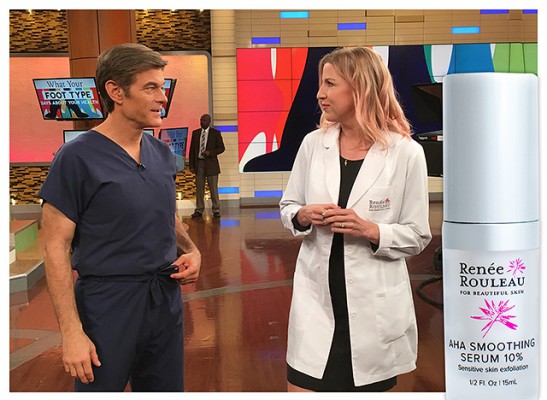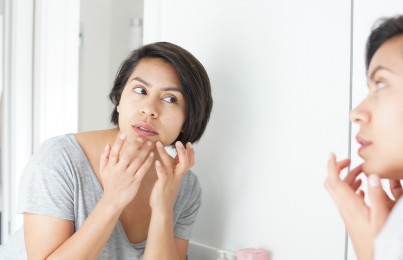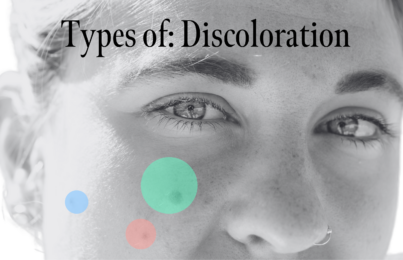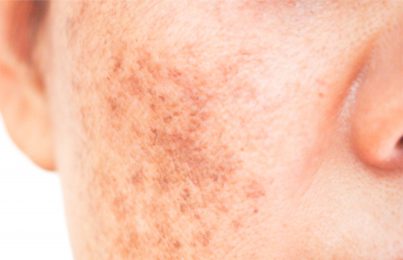Trendy ingredients will come and go but exfoliating acids like glycolic, lactic and salicylic have been a mainstay in skin care products for many years because of their proven effectiveness for treating conditions like dryness, acne, clogged pores and brown discoloration from the sun, hormones and breakouts.
Many people hear the word ‘acid’ and they immediately assume the skin will peel and turn red. But I’m here to tell you that not all acids are equal and when used at home in the right frequency, this should not happen. Instead, the skin looks clearer, brighter, smoother, and younger-looking (with continued use). I’ve personally been using acids on my skin, as well as recommending them to my clients since they first entered the scene in the late 1980s, and they are absolutely my favorite ingredients. (Today, they are more stable and controlled than they used to be.) I believe they should be used by everyone looking to improve the appearance of their skin.
I filmed a segment for the The Dr. Oz show where I discussed some of the benefits of exfoliating acids. Since the segment was a quick one, I wasn’t able to go into much detail, so I will do that here on my popular blog so you can know exactly which ones are best for your skin type, and how to work them into your skincare routine
So, let’s get started with everything you need to know.
What exactly is an exfoliating acid? Acids are ingredients used in cleansers, toners, masks, serums and moisturizers that when applied, lower the pH of the skin to chemically dissolve and digest the glue that holds cells together to encourage removal of surface dry cells. When these are removed, it makes the way for new, healthy cells that reflect light and give the skin a brighter glow. The ideal pH for home care products is between 3 and 4, but it’s not usually listed on the packaging so you may have to ask your skin care professional. With continued use, acids will improve many different conditions—all while smoothing the skin.
What skin care conditions does exfoliation help improve?
For clearing acne-prone skin: Exfoliation should be the main focus of a home care program for those with blemishes. The traditional approach for breakouts has been to dry out the skin with harsh acne products. Although this can destroy acne-causing bacteria, it tends to irritate and dehydrate the skin, which often times leads to future breakouts. Why? When you over-dry the skin, you create surface dry skin cell buildup which then creates as a barrier to trap oil in the skin, thereby starting a cycle of new breakouts. One of the best products to reduce bacteria, exfoliate and clear clogged pores without drying out the skin is BHA Clarifying Serum. It uses three different acids; salicylic, glycolic and lactic acid that are all extremely beneficial for the needs of blemish-prone skin. For both teens and adults with acne, this product works incredibly well to give a newly refined smoothness and clarity. To give a boost of results, use this peel.
For fading post-breakout red and dark marks: Often, the real concern is not so much the actual blemishes, but rather the red, dark marks that remain on the skin long after the breakout has healed. The key to fading those post-breakout marks is to increase your exfoliation. The more you remove the surface damaged cells, the more you are ridding the skin of the dark marks and encouraging the formation of new healthy (non-scarred) skin cells. The result is more even-toned skin with less scarring. Lactic and glycolic acids are excellent for this type of condition. I recommend that my clients use Post-Breakout Fading Gel to fade stubborn acne scars. (Of course, you don’t want to pick at your blemishes to create unnecessary scarring. If you’re a skin picker, read these posts to get my helpful tips for breaking this skin-damaging habit.)
For clearing clogged pores: Clogged pores aren’t infected blemishes, but rather blackheads, small whiteheads, and little clogged bumps on the skin, often on the forehead and chin. The same rules apply as with blemished skin. The more you remove surface dry skin cells (usually caused by using harsh, drying products), the less oil will stay trapped and congested in the pores. I recommend to my clients with clogged pores, to wash daily using a product like AHA/BHA Cleansing Gel (named “Best Cleanser for Oily/Acne Prone Skin” by Allure Magazine) to reduce breakouts and clear clogged pores.
For smoothing dry skin: Exfoliation is very important, especially in winter. When the skin is dry, we tend to load up on heavier creams to compensate for the dryness, right? But dry skin means you have dry skin cell buildup and the more you layer on heavier creams, the more you are trying to re-hydrate dry skin cells, which makes no sense. Instead, increase your exfoliation by using acids to remove the dry skin cells. This way, when you moisturize, you’re ensuring new cells stay moist and dewy. The type of acid you need to use depends on your skin type, but generally, glycolic or lactic acids work best for dry skin. AHA Smoothing Serum 10%, 17% or 20% are some of the formulas I suggest for those wanting to manage dryness.
For fading and brightening discoloration and brown sun spots: These are the brown spots that come from age, pregnancy, hormonal changes, and genetics. These spots can become quite apparent and darker starting in the late 30s since melanin (pigment) cells rise to the surface with age. Exfoliation is beneficial for breaking up the pigmented cells to allow them to fade. Glycolic acid (like AHA Smoothing Serum 10%, 17% or 20%) and lactic acid work well when used in a nighttime skin regimen to get a more even skin tone over time. During the day, it’s helpful to use a product with a skin lightening agent, such as vitamin C (found in Vitamin C & E Treatment) or hydroquinone (available OTC or by prescription) to accelerate the fading process.
For smoothing wrinkles and making large pores appear smaller: The skin’s natural exfoliation process slows as the skin ages, resulting in an accumulation of dry skin cells. As you increase your exfoliation, you are tricking the skin into acting young again. While acids perform really well on the surface to smooth the skin (especially a potent formula like this one), a vitamin A ingredient like retinoic acid or retinol works within the deeper layers of the skin skin to jump start tired, aging cells. In the process, it repairs the lower layers where collagen and elastin reside and with continued use, pores will appear smaller, and skin will look smoother and younger each day. Vitamin A can also be found in Renova, Retin-A and Avita which are all available by prescription. Advanced Resurfacing Serum uses retinol and is a great formula for sensitive skin, and it does not require a prescription. This is what I personally use on my own skin, and I recommend it to my sensitive skin clients as well. You can read all about how to use both retinol (vitamin A products together with exfoliating acids here.
FAQ’S about exfoliating acids.
Q. “I’m sensitive to acids and can’t use them. I once used a product with an acid and it irritated my skin. How can I gently give my skin exfoliation?”
A. Trust me when I say, not all acids are equal and not all acid-based products are created equal. Every product is formulated differently and you simply can’t expect all products to give the same result. When I have a client that shares this concern with me, I recommend they patch test the product on a small area of the face before introducing it to the entire face. Once they feel confident that their skin won’t react negatively, I will then advise them to start using it only one night a week for the first three weeks and then gradually move up to three nights. It’s very rare that I have someone who can’t use any product with an acid at all—especially if they are using it as directed for their skin type.
Read this post about ingredients used in products.
Q. “When I first started using an acid serum, I noticed a huge improvement in my skin but now that I’ve been using it for a while, I don’t see as much results. Is my skin getting used to it and it’s not working anymore?”
A. For starters, with any type of product (with or without acids), your skin doesn’t get used to a product and stop working. While your skin can build up a tolerance to topical prescription retinoids resulting in less negative side effects over time (which is a good thing!), there is no direct mechanism for your skin to become immune to the effects of skin care products. However, what can happen with people, is that their skin can reach a visible plateau where they forget what their skin looked like before they started using new products. So if you’re not seeing as many results a few months after starting a new routine with acids, it’s simply that you’re seeing a new normal. However, sometimes certain skin types (particularly oily and acne prone) require more exfoliation to get into the pore lining to clear out debris that leads to bumps and breakouts. For this type of skin, I always suggest for them to use Triple Berry Smoothing Peel a few times a month. It works incredibly well to give a boost of results with exfoliation.
Q. “Is it normal for an acid product to tingle on the skin when applied?”
A. Yes, some skin types can experience a stinging sensation when a serum is applied to the skin but this should settle down quickly once moisturizer is applied. This tingle has to do with the product being acidic (lower than your skin’s natural pH) combined with invisible cracks in your skin’s moisture barrier (found more so in dry skin types) that stimulate nerve endings to create this sensation. It’s important to note that a tingling feel (or lack of) is not an indicator of product’s effectiveness, it generally has more to do with the current state of your skin; such as climate, the amount of surface dead cells your skin has, and more.
Q. “Which type of acid is best for me?”
A. Take this Skin Type Quiz to get recommendations.
Q. “What are the differences between acids that can be used at home and getting a chemical peel at a doctor’s office or professional spa that uses acids?”
A. The biggest point of difference between what is used at home versus acids used in a professional chemical peel treatment is strength—and the higher percentage and lower the pH it is, the stronger it will feel and react on the skin. Redness, dryness, peeling and flaking are all normal side effects of chemical peels, but this is not at all what you should be experiencing with at-home acid serums. The ‘no pain, no gain’ is NOT the approach you want in your daily skincare regimen. (Read more about chemical peels here.)
Q. “What are the best ways to use exfoliating acids?”
A. Read 8 Tips For Using Exfoliating Acids Correctly.
Q. “How often should I be exfoliating?”
A. To effectively use an acid serum, apply a thin coat to entire face after cleansing and toning. Follow with a night cream recommended for your skin type. Use for three nights on, three nights off, with a hydrating skin serum (view my recommendations) on alternate nights. The reason for this method of use is because your skin needs a balance and not the same ingredients night after night. When you use an acid serum three nights in a row, every night it works a little deeper within the skin to give the best exfoliation. After three nights, you’re exposing these fresh, new cells so you want to give them other beneficial ingredients like hydrators, brighteners and tighteners to provide nourishment.
Q. “I started using an exfoliant and got some blemishes. Should I not be exfoliating?”
A. Read Is It Normal To Break Out When Using Exfoliating Products?
Q. “Can I use an exfoliants around my eyes?”
A. Read Are You Exfoliating Around Your Eyes? If Not, You Should Be
Q. “In the summer, should I exfoliate less often?”
A. Read Should I Exfoliate Less Often In The Summer?
Read: Why Most Acne Spot Treatments DON’T Work
Read: Five Ways To Hydrate Oily, Acne-Prone Skin Without Causing Breakouts
Which skin care products are best for you? See these nine skin types or take the Skin Type Quiz and get product recommendations.
Need expert advice from a licensed esthetician? Schedule a virtual consultation to get customized advice in person, over the phone or online via Skype or FaceTime.
For more expert advice check out the blog. Also sign up for our skin tip e-newsletter, follow Renée Rouleau on Twitter and Instagram and join the discussion on our Facebook page. You’ll be your own skin care expert in no time. Get the #ReneeRouleauGlow!
Celebrity Esthetician & Skincare Expert
As an esthetician trained in cosmetic chemistry, Renée Rouleau has spent 35 years researching skin, educating her audience, and building an award-winning line of products. Her hands-on experience as an esthetician and trusted skin care expert has created a real-world solution — products that are formulated for nine different types of skin so your face will get exactly what it needs to look and feel its best. Trusted by celebrities, editors, bloggers, and skincare obsessives around the globe, her vast real-world knowledge and constant research are why Marie Claire calls her “the most passionate skin practitioner we know.”




Comments:
So excited just got my first order in the mail yesterday. I should have asked before I started, but I did start Last night with the night bio-radiance night serum. Should I then go with 3 nights of the AHA 17% smoothing serum? Then night serum again for 1 night? Would appreciate the help. I want to make sure I’m following the correct order.
Posted By: Stacy |
So glad that you’re getting on my line, Stacy! It doesn’t matter which serum you start with so using the Bio Radiance for the next three nights is perfectly fine. Enjoy!!
Posted By: Renée Rouleau |
I’m so confused about all the different serums, creams, toners, exofilators there are out there. I wake up to oily skin mainly on my cheeks but after washing my face, it gets tight & flaky & starts to peel off a little. I can’t even wear foundation because it’ll start to flake & crack even after moisturizer. I still don’t know which products are for me. Ive been using a Hyaluronic acid for a while now & my skin still feels tight after it. If you can help me, i’d be delighted & very thankful.
Posted By: Liz |
Hi Liz, It sounds like your skin is severely dehydrated which will make it feel tight and get flaky, but it can also cause the skin to get oily because when the skin is dehydrated, the skin can push out more oil to compensate for water loss. I would suggest you take my Skin Type Quiz and see my 9 skin types here. Your skin desperately needs balancing with quality skin care products. Renee Rouleau is the perfect place to come to. Take the quiz and it will suggest products for you at the end. Email customer service at our website if you need more personalized assistance. You’ll love our line.
Posted By: Renée Rouleau |